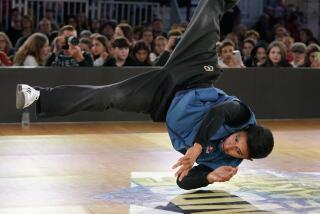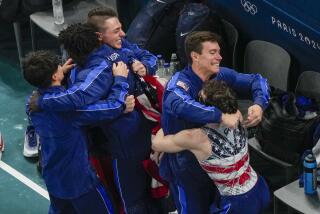Zoeggeler Has the Right Stuff
- Share via
CESANA PARIOL, Italy — For most of the afternoon and into the evening, the crowds that lined the frozen track to watch the men’s luge competition seemed sparse and hushed.
It wasn’t until the final slider arrived at the start house that an honest-to-goodness roar erupted from the grandstands, a noise that seemed too loud for the 3,000 or so in attendance.
Armin Zoeggeler -- a dominant force in luge and, more important, something of an Italian sports celebrity -- rocked back and forth at the top of the course, needing one strong run to bring the host nation its first gold medal of these 2006 Winter Games.
Zoeggeler came through, edging Albert Demtschenko of Russia for the singles luge title and igniting a Sunday night celebration in the mountains outside Turin.
Flags waved and cowbells clanged. Fireworks burst across the sky in green and red. The president of Italy, Carlo Azeglio Ciampi, called on a cellphone to offer his congratulations.
It was a moment of passion from Italian citizens who, to that point, had been acting nonchalant about these Games.
And it all seemed a bit mystifying to the newly crowned champion.
“I don’t feel a national hero,” an unsmiling Zoeggeler said through an interpreter. “I am what I am.”
His victory, and the subsequent rejoicing, overshadowed a piece of luge history.
Georg Hackl of Germany, the most decorated slider ever, finished seventh in what he announced was the final race of his career.
Nicknamed “The Sliding White Sausage” because of a hefty physique stuffed into a tight racing suit, Hackl had won medals in five consecutive Olympics, three of them gold.
“I feel relieved,” he said through an interpreter. “There have been a lot of ups and downs in my career, and I realize the most important part of my life in luge is over.”
Sunday night also marked a missed opportunity for the United States’ luge program.
Until Zoeggeler’s winning run, Tony Benshoof of White Bear Lake, Minn., stood in fourth place with a chance to be the first American to win a medal in singles luge.
“I felt the same thing I feel on every competition run,” he said. “A little more pressure, obviously, but I went after it.”
Benshoof got his fastest start of the week and cut a clean path down the one-mile course, temporarily taking the lead. But then Martins Rubenis of Latvia followed with a run that was 0.15 of a second faster and ultimately took bronze.
“To be honest with you, I thought it would be enough to get on the podium,” Benshoof said of his performance. “What can you do?”
None of this -- not Hackl’s goodbye or Benshoof’s near miss -- factored into the equation for the Italian fans. Nor did it seem to matter that Cesana Pariol had been the subject of controversy before the Games.
In early runs at the new track, numerous sliders had crashed and the facility had to be closed for alterations. Officials limited further practices and many international sliders, who usually get dozens of runs on a new course, arrived here with far fewer.
Only the Italian team had really gotten a chance to grow accustomed to Cesana Pariol.
But no one could argue about the winner, not when he had also taken gold in 2002 and earned medals in two earlier Olympics.
About the only topic of debate was how much this victory meant.
Zoeggeler, a 32-year-old police officer, said it felt pretty much like other wins in his career.
“Well, a gold medal is always an extraordinary experience,” he calmly explained. “I don’t think there’s anything specific in terms of a difference.”
The fans outside, still making noise long after the event had ended, seemed to disagree.
*
(BEGIN TEXT OF INFOBOX)
Slippery slope
Combine aerodynamic design, modern light-weight materials and an icy-fast downhill track, and you’ve set the stage for perhaps the most exciting and dangerous Olympic events - bobsled, luge and skeleton.
Venue: Cesano Pariol
Dates: Luge-Saturday (11-15); Skeleton-Thursday (16-17), Trials, semifinals and finals on same day; Bobsled-Saturday (18-21), Friday (24-25), trials, semifinals and finals on same day
The course: The sledding track is the venue for the two- and four -man bobsled, skeleton, luge and doubles luge events. The course is 4,708 feet long and drops 374 feet from start to finish. Sleds can reach speeds of 80-90 mph and up to 4-G forces on the 11 left-hand and 8 right-hand curves. After the finish line, the track turns uphill to help the racers slow down. About 7,000 spectators can watch the sledding competitions.
Winning: The times for each athlete’s or team’s runs are added together. The competitor with the fastest combined time wins the gold.
*
Bobsled
Led by driver Todd Hays and brakeman Pavle Jovanovic, the U.S. bobsled team will look to improve on its 2002 silver medal in the four-man competition. Olympic rookie Steven Holcomb will drive the other U.S. sled.
The sleds: Costing as much as $35,000 to build, sleds ride on a set of four runners that alone can cost $5,000. A variety of runners are needed for different track configurations, ice and weather.
The teams: In addition to Hays, Holcomb and Jovanovic, the U.S. team consists of pushers Steve Mesler, Bill Schuffenhauer and Randy Jones (all 2002 Olympians), and Brock Kreitzburg, Curt Tomasevicz and Lorenzo Smith III. In the two-man sled, Hays will probably team with Jovanovic or Mesler.
History
First sleds had rope steering and a garden rake for a brake.
Bobsled first appeared in the Olympics in 1928, when Billy Fiske of the U.S. won the gold. Dimensions:
2-man bobsled
Weight: 860 pounds
Length: 8 feet 9 inches
4-man bobsled
Weight: 1,388 pounds
Length: 12 feet 6 inches
Brakeman: Stops the sled at end of race by engaging a metal claw.
Driver: Team leader steers the sled. Must have quick reactions and hand-eye coordination to control front runners via a slight movement of the fingers.
Pusher (each side): Provide crucial push at the start before jumping into sled. Their pecial shoes have 500 tiny spikes.
Runners: Centrifugal force pulls the sled up the sides of the track
Steering: Ropes attached to the front axle provide a turning angle up to 12-degrees.
*
Luge
American Tony Benshoof finished fourth Sunday in the singles. Mark Grimmette and Brian Martin have a chance of medaling in the doubles for the U.S.
Dimensions:
Weight:51 lbs. (singles); 60 lbs. (doubles)
Length:57.6 inches (from tip of bows to rear)
Width:21.7 inches
*
Skeleton
U.S. medal hopefuls are Eric Bernotas, Kevin Ellis and Katie Uhlaender.
Dimensions:
Weight:254 lbs. (men); 203 lbs. (women)
Length:31.5 to 47.2 inches
Width:13.4 to 15 inches (between runners)
*
Sources: U.S. Bobsled and Skeleton Federation; usolympicteam.com; USOC. Graphics reporting by Joel Greenberg
More to Read
Go beyond the scoreboard
Get the latest on L.A.'s teams in the daily Sports Report newsletter.
You may occasionally receive promotional content from the Los Angeles Times.







